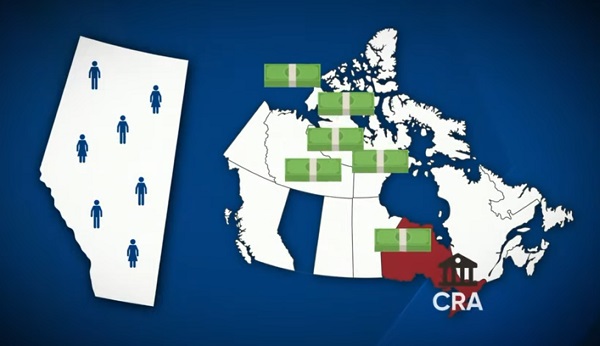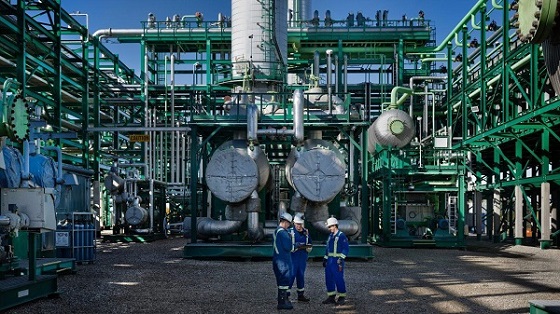Alberta
Hydro-Québec takes partnerships, environmental measures and sharing of wealth to new levels

The Canadian Energy Compendium is an annual Energy Council of Canada initiative which provides opportunity for cross-sectoral collaboration on a topic of shared interest across the Canadian energy sector, produced with the support of Canada’s national energy associations and Energy Council of Canada’s members. The stories contributed to the 2019 edition, Indigenous Energy Across Canada, highlight current conversations celebrating Canada’s dynamic energy sector and encouraging its continuous improvement.
Thanks to Todayville for helping us bring our members’ stories of collaboration and innovation to the public.
Click to read a Foreward from JP Gladu, Chief Development and Relations Officer, Steel River Group; Former President & CEO, Canadian Council for Aboriginal Business

JP Gladu, Chief Development and Relations Officer, Steel
River Group; Former President & CEO, Canadian Council for Aboriginal Business
THE THIRD PHASE OF JAMES BAY DEVELOPMENT: TAKING PARTNERSHIPS, ENVIRONMENTAL MEASURES AND SHARING OF WEALTH TO NEW LEVELS
This article, submitted by Hydro-Québec, will focus on the development of the third phase of the James Bay complex, namely the generating stations namely the Eastmain-1 and Eastmain-1A/Sarcelle/Rupert project. Emphasis will be placed on the development of a new relationship with the Cree that led to an improved project development model.
The Eastmain Complex, the most recent of the James Bay hydroelectric development: Taking partnerships, environmental measures and sharing of wealth to new levels.
When the initial phases of hydropower development in the Baie-James region of Québec was launched in the 1970s, there was no law on the environment, no environmental ministries and no environmental impact assessment process. So consulting affected communities wasn’t on anyone’s agenda and wasn’t yet part of Hydro-Québec’s approach. In the new millennium, with a new phase of development in this region, close-knit partnerships with the Cree Nation have become the cornerstone of project development throughout Québec.
Nadoshtin and Boumhounan agreements paved the way to new developments in Baie-James in the 2000s
The Nadoshtin agreement (2002) between the Crees and Hydro-Québec opened up the possibility of building and operating the Eastmain-1 hydropower project, while the Boumhounan agreement (2002) provided a framework for the Eastmain 1- A/Sarcelle/Rupert project. The key to success for the Eastmain projects was partially diverting the Rupert River’s flow northward.
But Hydro-Québec’s commercial interest in this new project had to be balanced by clear and extensive measures to preserve the surrounding environment and respect host Cree Nation and Cree communities.
In the framework of the Eastmain-1 project, Hydro-Québec made a number of commitments with a view to
- reduce the project’s impacts on the environment
- protect the Cree way of life and encourage partnerships with the Cree communities
- encourage the awarding of contracts to Cree businesses
- promote the training and hiring of Cree workers.
- built local capacity
“…The company wanted to do more than minimize environmental impact; Hydro-Québec wanted community members to see positive gains from the Eastmain developments…”
From the design stage, which was carried out in concert with the Cree, the Eastmain 1-A/Sarcelle/Rupert project incorporated many environmental protection measures, reflecting the Cree traditional knowledge of the community members they consulted. The Cree of Québec were involved in all stages of the project, ensuring they had a voice in how their land would be impacted.

Photo courtesy Hydro-Québec. Yellow sturgeon are raised in a fish hatchery and released into their natural habitat in mid-September, when they have reached a certain maturity. Cree tallymen assist in releasing the fish into the Rupert River in the Baie-James region.
With input from Cree community members, Hydro-Québec devised a combination of dikes and canals to improve water flow, ensuring that the project, which diverts 71% of the river’s flow, flooded only a minimal land area. They also incorporated a substantial ecological in-stream flow and a series of weirs in the river to protect fish habitats, biological diversity, preserve the landscape, and maintain navigation and other activities in the area.
Furthermore, Hydro-Québec signed an unprecedented water management agreement with the Cree to ensure that the modulation of the ecological in-stream flow was managed in a cooperative manner.
Economic spinoffs
In addition to helping preserve the local environment, Hydro-Québec was committed to bringing growth opportunities to the Cree of Québec. The company wanted to do more than minimize environmental impact; Hydro-Québec wanted community members to see positive gains from the Eastmain developments.
Under the Boumhounan Agreement, an extensive participation program built around information and consultation with Cree stakeholders was put in place. It also made funds available for the Cree to finance fisheries, capacity building and traditional activities projects.
When the Eastmain 1A/Rupert diversion project was completed in 2013, the Cree and Hydro-Québec signed the Reappropriation Agreement, giving Cree land users the necessary support to maintain their traditional activities as long as the Rupert River diversion is in operation.
Post-project consultations: ensuring that measures were effective
The COMEX, a joint committee composed of 3 members appointed by the Government Quebec and 2 members appointed by the Cree Nation government, organized consultations with Cree communities to hear their views on the effectiveness of environmental and social mitigation measures put in place for the Eastmain 1A/Rupert diversion project. Approximately 200 members of the Cree Nation from six communities participated in the consultations organized in November 2012.

Photo courtesy Hydro-Québec. Between 2002 and 2005, prior to the impoundment of the Eastmain-1 reservoir, 50 archeologists and Cree workers undertook archeological digs. They discovered 158 sites and their work shows that the Baie-James territory has been occupied by these populations for the last 5,000 years.
The major findings of the COMEX were as follows:
- […]”the Committee is convinced that the Eastmain-1-A and Sarcelle Powerhouses and Rupert Diversion Project will have contributed to greater understanding between all the parties concerned, to greater Cree involvement in the development of the territory, and perhaps to empowering them to achieve their long- term economic and community development goals.”
- “Compared to previous projects carried out in the territory, the Eastmain-1- A/Sarcelle/Rupert project included more adequate and an unprecedented number of mitigation and compensation measures, for both environmental and social impacts. Many of these measures are aimed at helping Cree land users reclaim the territory. A new approach was developed and the Crees have benefited from the partnerships built with the proponent, thereby forging a new relationship.”
- “Hydro-Québec was proactive, exceeding the requirements of the certificate of authorization in an effort to minimize the project’s impacts and ensure greater Cree involvement in environmental and social follow-up activities.”
- “Hydro-Québec went to great lengths to ensure that Aboriginal communities derive benefit from the project.”
A new project development model
The Eastmain Complex – the most recent phase of development in Baie-James – added a potential energy output of 8.7 TWh per year, enough to power more than 500,000 Québec homes. The new relationships that Hydro-Québec and the Cree Nation developed over that period have become models for future energy resource development throughout Québec. With considerable untapped hydropower potential and a strong wind potential in Québec, Hydro-Québec’s new and improved project development model holds great promise for the future of clean energy in northeast North America.

Jacob Irving, President of Energy Council of Canada
The Canadian Energy Compendium is an annual initiative by the Energy Council of Canada to provide an opportunity for cross-sectoral collaboration and discussion on current topics in Canada’s energy sector. The 2020 Canadian Energy Compendium: Innovations in Energy Efficiency is due to be released November 2020.
Click to read comments about this series from Jacob Irving, President of the Energy Council of Canada.
Alberta
Alberta Next: Taxation

A new video from the Alberta Next panel looks at whether Alberta should stop relying on Ottawa to collect our provincial income taxes. Quebec already does it, and Alberta already collects corporate taxes directly. Doing the same for personal income taxes could mean better tax policy, thousands of new jobs, and less federal interference. But it would take time, cost money, and require building new systems from the ground up.
Alberta
Cross-Canada NGL corridor will stretch from B.C. to Ontario

Keyera Corp.’s natural gas liquids facilities in Fort Saskatchewan. Photo courtesy Keyera Corp.
From the Canadian Energy Centre
By Will Gibson
Keyera ‘Canadianizes’ natural gas liquids with $5.15 billion acquisition
Sarnia, Ont., which sits on the southern tip of Lake Huron and peers across the St. Clair River to Michigan, is a crucial energy hub for much of the eastern half of Canada and parts of the United States.
With more than 60 industrial facilities including refineries and chemical plants that produce everything from petroleum, resins, synthetic rubber, plastics, lubricants, paint, cosmetics and food additives in the southwestern Ontario city, Mayor Mike Bradley admits the ongoing dialogue about tariffs with Canada’s southern neighbour hits close to home.
So Bradley welcomed the announcement that Calgary-based Keyera Corp. will acquire the majority of Plains American Pipelines LLP’s Canadian natural gas liquids (NGL) business, creating a cross-Canada NGL corridor that includes a storage hub in Sarnia.
“As a border city, we’ve been on the frontline of the tariff wars, so we support anything that helps enhance Canadian sovereignty and jobs,” says the long-time mayor, who was first elected in 1988.
The assets in Sarnia are a key piece of the $5.15 billion transaction, which will connect natural gas liquids from the growing Montney and Duvernay plays in B.C. and Alberta to markets in central Canada and the eastern U.S. seaboard.
NGLs are hydrocarbons found within natural gas streams including ethane, propane and pentanes. They are important energy sources and used to produce a wide range of everyday items, from plastics and clothing to fuels.
Keyera CEO Dean Setoguchi cast the proposed acquisition as an act of repatriation.
“This transaction brings key NGL infrastructure under Canadian ownership, enhancing domestic energy capabilities and reinforcing Canada’s economic resilience by keeping value and decision-making closer to home,” Setoguchi told analysts in a June 17 call.
“Plains’ portfolio forms a fully integrated cross Canada NGL system connecting Western Canada supply to key demand centres across the Prairie provinces, Ontario and eastern U.S.,” he said.
“The system includes strategic hubs like Empress, Fort Saskatchewan and Sarnia – which provide a reliable source of Canadian NGL supply to extensive fractionation, storage, pipeline and logistics infrastructure.”
Martin King, RBN Energy’s managing director of North America Energy Market Analysis, sees Keyera’s ability to “Canadianize” its NGL infrastructure as improving the company’s growth prospects.
“It allows them to tap into the Duvernay and Montney, which are the fastest growing NGL plays in North America and gives them some key assets throughout the country,” said the Calgary-based analyst.
“The crown assets are probably the straddle plants in Empress, which help strip out the butane, ethane and other liquids for condensate. It also positions them well to serve the eastern half of the country.”
And that’s something welcomed in Sarnia.
“Having a Canadian source for natural gas would be our preference so we see Keyera’s acquisition as strengthening our region as an energy hub,” Bradley said.
“We are optimistic this will be good for our region in the long run.”
The acquisition is expected to close in the first quarter of 2026, pending regulatory approvals.
Meanwhile, the governments of Ontario and Alberta are joining forces to strengthen the economies of both regions, and the country, by advancing major infrastructure projects including pipelines, ports and rail.
A joint feasibility study is expected this year on how to move major private sector-led investments forward.
-

 Fraser Institute1 day ago
Fraser Institute1 day agoBefore Trudeau average annual immigration was 617,800. Under Trudeau number skyrocketted to 1.4 million annually
-

 MAiD1 day ago
MAiD1 day agoCanada’s euthanasia regime is already killing the disabled. It’s about to get worse
-

 Frontier Centre for Public Policy1 day ago
Frontier Centre for Public Policy1 day agoNew Book Warns The Decline In Marriage Comes At A High Cost
-

 Business1 day ago
Business1 day agoPrime minister can make good on campaign promise by reforming Canada Health Act
-

 Addictions1 day ago
Addictions1 day ago‘Over and over until they die’: Drug crisis pushes first responders to the brink
-

 International1 day ago
International1 day agoChicago suburb purchases childhood home of Pope Leo XIV
-

 Daily Caller1 day ago
Daily Caller1 day agoUSAID Quietly Sent Thousands Of Viruses To Chinese Military-Linked Biolab
-

 Business2 days ago
Business2 days ago103 Conflicts and Counting Unprecedented Ethics Web of Prime Minister Mark Carney




